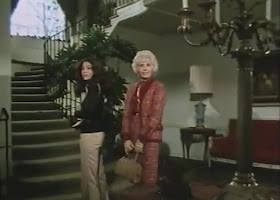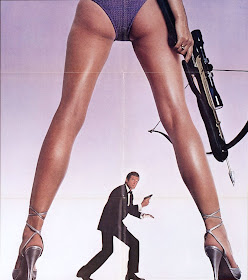 |
| The shipwrecked soldiers vs bad-tempered giant crab |
Jules Verne's Mysterious Island, which was inspired by Robinson Crusoe, was first filmed as a silent in 1929, turned into one of the worst movie serials ever in 1951, and finally became a worthwhile motion picture vehicle ten years later. During the siege of Richmond in 1865, several union soldiers, a war correspondent, a freed slave, Neb, (along with one rebel soldier) escape from prison in a balloon and wind up on an isolated island miles from anywhere. The film makes two major additions to Verne's story: two shipwrecked women appear on the island; and there are also giant monsters for FX stop-motion master Ray Harryhausen to play around with. [Harryhausen claimed the story would not be entertaining without them, but this is nonsense -- actually without the monsters Harryhausen would have had little to do.] Originally the monsters were supposed to be prehistoric creatures, but it was decided to make them products of growth experiments conducted by Captain Nemo (Herbert Lom), who has taken refuge in his submarine Nautilus in an underground grotto. British actor Michael Craig may seem an odd choice to play Union soldier Captain Harding, but he does a convincing American accent and is quite good and authoritative, although he seems completely different from the star of Doctor in Love, which he did the previous year. Gary Merrill gives one of his best performances as the reporter Spilitt, and Michael Callan is also notable in his turn as the boyish and frightened but ultimately courageous young Herbert. Joan Greenwood gives her usual affected performance as Lady Fairchild [she thickly stretches out her words to a comical degree], and Beth Rogan is at least decorative as her niece. Percy Herbert and Dan Jackson as the reb and Neb round out the cast and are fine.
But the two greatest contributions are made by composer Bernard Herrmann and Ray Harryhausen. Herrmann's score is excellent, beginning with the rousing opening theme and including the quirkier music for the attack by the giant. funny-looking bird. You might quibble with the quality of some of the process shots, but Harryhausen's animation is excellent. In addition to the big bird, we've got that wonderful giant crab, huge, buzzing bees, and -- perhaps best of all -- that baleful squid who attacks the men in the climax after fixing them with its giant, evil eye. Wilkie Cooper's cinematography employs highly attractive lighting schemes. Director Endfield [Sands of the Kalahari] keeps things moving at a good pace. The underwater sequences are very well-done and we're even treated to shots of the sunken city of Atlantis.
I've always wondered why this film isn't as well-known or well-received [although it was quite successful] as Disney's adaptation of 20,000 Leagues Under the Sea. For my money Mysterious Island is a much better picture, and the squid in the former can't compare to Harryhausen's impressive, slithering creation.
Verdict: Exciting and colorful with wonderful effects. ***1/2.





























